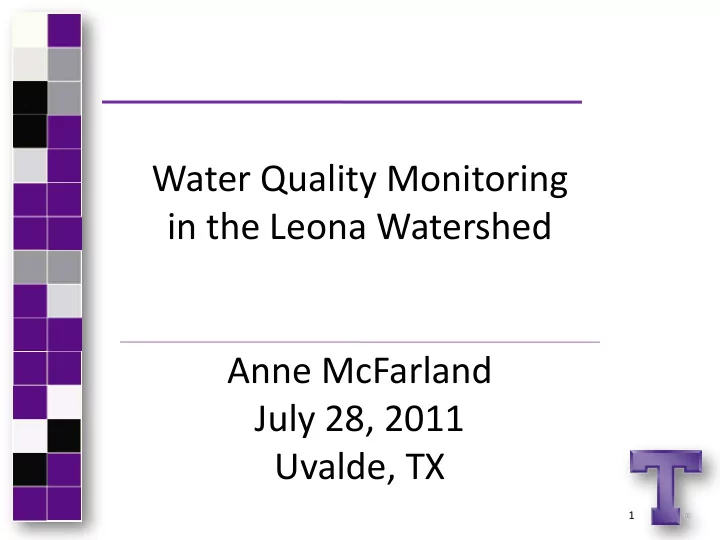

Water Quality Monitoring in the Leona Watershed Anne McFarland July 28, 2011 Uvalde, TX 1
Leona River Segment 2109 303(d) List & Assessment • Category 5c for bacteria – Standard is not attained recreational use, but additional data and information will be collected before a TMDL is scheduled • Assessment concern for nitrates How was this determined? 2
Routine Quarterly Monitoring • Conducted through C lean R ivers P rogram by TCEQ and the Nueces River Authority • 4 Stations: – 18418 Leona River upstream of FM 140 (south of Uvalde) – 12989 Leona River at Hoags Dam (below confluence of Cooks Slough, SE of Uvalde) – 12987 Leona River on Hwy 57 (east of Batesville ) – 12985 Leona River on FM 1581 (most downstream site) 3
Three Assessment Units • AU_01 (lower end of segment to confluence with Yoledigo Creek) • AU_02 (confluence of Yoledigo Creek to the confluence with Camp Lake Sough) • AU_03 (from confluence of Camp Lake Sough to upper end of segment) 4
5
Water Quality Inventory 2010 • Assessment Period: – December 1, 2001 – November 30, 2008 • Data compared to criteria or screening levels for assessment • All parameters assessed as fully supporting or of no concern except E. coli & nitrate 6
E. coli Assessment Geometric Mean E. coli Criteria E. coli Number of (colonies/100 (colonies/100 Samples mL) mL) Assessed AU_01 171 126 21 AU_02 233 126 23 AU_03 202 126 31 7
Nitrate Assessment Average Screening Number Number Nitrate Level Samples Samples Percent (mg/L) (mg/L) Assessed Exceed Exceed AU_01 8.17 1.95 23 21 91% AU_02 3.89 1.95 27 23 85% AU_03 2.60 1.95 28 26 93% 8
More Monitoring Data Needed Current monitoring data are considered adequate for assessing impairments and concerns, but not for identifying sources & solutions, therefore, more monitoring data are needed. Proposed Sampling Design focuses on monitoring E. coli and nitrate 9
Monitoring Parameters Include: • E. coli • Nitrite/nitrate-nitrogen • pH • Dissolved oxygen • Specific conductance • Water temperature • Flow 10
Surface Water Quality Monitoring • Routine Ambient Monitoring – Once every two weeks – 9 Mainstem Sites • Targeted Watershed Monitoring – Monthly – 7 Tributary Sites • Routine Effluent Monitoring – Monthly – 3 Wastewater Treatment Facilities & 1 Permitted Discharge • Springflow Monitoring – Quarterly – Up to 5 Springs 11
Proposed Leona Sampling Sites 12
Recreational Use Attainability Analysis (RUAA) Purpose: Ascertain suitability of stream for contact recreation and assess factors that promote/hinder contact recreation along stream. Includes a historical assessment as well as a current use assessment. 13
Recreation Uses – 2010 Standards Expanded Use Categories Primary Contact Recreation (PCR) Secondary Contact 1 (SCR1) Secondary Contact 2 (SCR2) Noncontact Recreation (NCR) 14
Primary Contact Recreation (PCR) Activities that are presumed to involve a significant risk of ingestion of water (e.g. wading by children, swimming, water skiing, diving, tubing, surfing, and the following whitewater activities: kayaking, canoeing, and rafting). 15
Secondary Contact 1 (SCR1) Activities that commonly occur but have limited body contact incidental to shoreline activity (e.g., fishing, canoeing, kayaking, rafting and motor boating). 16
Secondary Contact 2 (SCR2) Similar to SCR1 but activities occur less frequently than SCR1 due to physical characteristics of the water body or limited public access. 17
Noncontact Recreation (NCR) Activities that do not involve a significant risk of water ingestion, such as those with limited body contact incidental to shoreline activity, including birding, hiking, and biking. Noncontact recreation use may also be assigned where contact recreation activities should not occur because of unsafe conditions, such as ship and barge traffic. 18
Expanded E. coli 2010 Standard Geometric Mean E. coli (colonies/100 Recreation Category mL) Primary Contact 126 Secondary Contact 1 630 Secondary Contact 2 1030 Noncontact 2060 19
RUAA: Goal is to Assess 3 Sites per Every 5 Miles of River 20
Sampling Design Questions? Suggestions 21
Recommend
More recommend